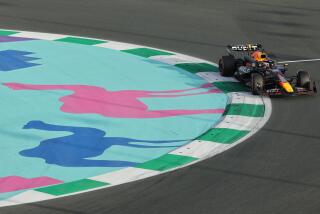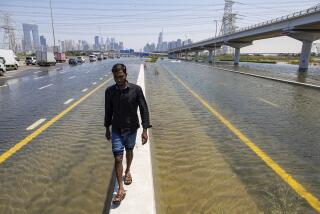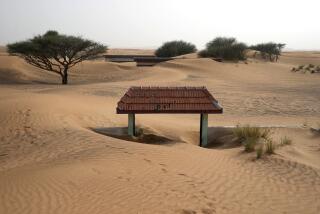Dubai a posh oasis in the Persian Gulf
Dubai, United Arab Emirates
In a place where a gallon of gasoline is almost as cheap as a liter of bottled water in the U.S., anything seems possible.
With the world’s tallest skyscraper and most opulent hotel, plus solar-powered parking meters, desalinated seawater from the taps, indoor alpine skiing and a new archipelago of artificial islands, the desert city of Dubai has transformed itself so completely that it now figures as one of the Eastern Hemisphere’s great, cosmopolitan centers, on a par with Singapore and Hong Kong.
But wedged on the Persian Gulf between Abu Dhabi and Sharjah (two of the seven mini-states that make up the United Arab Emirates), it is off the radar of many Westerners as a destination. When it’s thought of at all, it’s considered faraway, exotic and possibly dangerous, although the State Department has issued no warnings on it and the agency’s website says crime is not a problem.
After passing through Dubai International Airport several times on my way from Europe to the Far East, I finally decided to see the city-in-the-making during the Dubai Shopping Festival, which began Thursday and continues through Feb. 24. The fest celebrates the city’s favorite pastime with fireworks, concerts and up to 75% reductions on designer fashions, jewelry, electronics and curios from all over the Middle East, Africa and Asia.
The shopping was grand, the winter weather not unlike that in L.A. (summers, though, are much hotter) and I never worried about my safety.
But Dubai was the real amazement, a fast, sprawling, glitzy city that seems as ethnically diverse as Los Angeles and almost as surreal as Vegas. It contradicts clichés, changes radically from one year to the next, dreams big and -- so far -- always seems to win at what it gambles on.
I told Chris O’Donnell, the Australian-born chief executive of Nakheel, a government-linked real estate developer building four clusters of islands, that Dubai didn’t seem real to me.
“You have to ask yourself what is real and what’s not -- L.A. and Sydney [Australia] or this place,” he said. “Maybe Dubai has the pioneering spirit that has disappeared in America and Australia.”
A TINY STATE
Dubai the city is the heart and hub of a mini-state a little bigger than Rhode Island, with a population of 1.6 million, that sprang up in the 1830s when the Al Maktum clan from Abu Dhabi settled along an inlet of the gulf known as Dubai Creek.
It was a protectorate of Britain, sustained by trade between the East and West, and by fishing and pearl-diving, until 1971, when the British left and the United Arab Emirates was born.
Oil was discovered offshore five years earlier but in amounts dwarfed by the vast reservoirs in nearby Saudi Arabia; it’s expected to give out in the next few decades.
So it wasn’t black gold that put Dubai on the road to El Dorado. It was the vision of Sheik Rashid ibn Said al Maktum, the emirate’s beloved ruler from 1958 to 1990. He spurred the shipping industry by dredging the creek, gave the emirate one of the world’s largest man-made harbors and built the city’s first skyscraper, the Dubai World Trade Center, in 1979.
His equally farsighted son, Sheik Mohammed, reigns over an officially Islamic Dubai where smoking is banned in restaurants and hotels. (Many serve alcohol, but it’s otherwise generally unavailable in shops.)
All religions are tolerated here, and women are welcome in the workplace, whether they’re wearing Donna Karan or traditional floor-length black abayas. Manal Shaheen, a top female executive at Nakheel, is, by all reports, a force to be reckoned with. On one of my many taxi rides across the city, I had a female cab driver who wore a pretty pink abaya and had salty salutations for anyone who cut in front of her.
THE ATTRACTION
People come to Dubai from about 180 countries to make or spend their fortunes in this land without taxes. They account for a remarkable 80% of the population -- Indians, Africans and Southeast Asians in low-paying service and construction jobs predominate.
Although some of the richest Dubai emirs own mansions in ritzy Jumeirah Beach and trade in their Bentleys for new models every year, those immigrants with the lowest-paying jobs make as little as $150 a month and have difficulty getting visas for their families. Their plight is seen as one of Dubai’s major problems, along with traffic and pollution caused by rapid and ongoing development.
About $400 billion worth of tourism projects are expected to be launched by 2010 in hopes of drawing 15 million visitors a year. (Las Vegas, which attracted 38.9 million visitors last year, plans to spend only about 10% that amount on tourism.) Dubai’s projects include a public light rail system that is to be built in a four-year sprint, an air-conditioned outdoor Universal Studios Dubailand, a one-of-a-kind DreamWorks Animation theme park, a Tiger Woods-designed golf course and an underwater hotel.
If it can be imagined, it is, seemingly, on the drawing board -- or well on the way.
But it isn’t just that the city has taken an early lead into the 21st century; it’s the speed with which it has done so.
At the Dubai Museum, built underneath Al Fahidi Fort in the historic creek-side district of Bastakiya, high-tech exhibits document the city’s relatively brief recorded history, starting when Dubai was little more than a souk at the edge of the Arabian Desert.
A decade-by-decade photo gallery reveals the development of the city, which is caught up in a real estate boom that’s transforming the sky and coastlines.
In just a handful of years, two new high-rise districts have taken shape west of downtown, one like Miami Beach with hotels and residences between a man-made marina and the beach, the other an international business center along the desert flats of multilane Sheikh Zayed Road, where, it seems, every other lot is a construction site.
The cluster of postmodern skyscrapers there is dwarfed only by Burj Dubai, a tapering tower designed by the Chicago-based architectural firm Skidmore, Owings & Merrill. When it’s finished, perhaps later this year or early next, it will be twice the height of New York’s Chrysler Building (a mere 1,046 feet) and may take its place as the tallest skyscraper in the world.
Together with Burj Al Arab, the ultra-luxurious hotel shaped like an Arabian sailboat (see photo on the cover of the section), it is the pride of Dubai.
Rooms at Burj Al Arab are palatial, two-story suites starting at more than $1,000 a night. The clientele reflects that: actors Brad Pitt and Angelina Jolie, Gov. Arnold Schwarzenegger and Swiss tennis star Roger Federer.
Hoi polloi can reserve a table for a meal, high tea or cocktails at one of the hotel’s eight restaurants, then take a lightning-fast, glass-walled elevator to the 27th floor for a bird’s-eye view of the placid, aqua Persian Gulf, where, without the benefit of geologic activity, a swirling chain of islands is being created.
Only one of Nakheel’s five island-building projects -- three shaped like palm trees (Palm Jumeirah), one that approximates a map of the world and another, announced last week -- is close enough to completion for its property owners (including soccer star David Beckham, Bollywood leading man Shahrukh Khan and race car driver Michael Schumacher) to move in.
Ultimately, Palm Jumeirah will have vacation villas and apartments, a Trump International Hotel & Tower, an Atlantis resort, a monorail, a Barneys New York department store, a purpose-built Cirque du Soleil theater and the Queen Elizabeth 2, to be retired from oceangoing service and converted into a hotel, as its prime coconuts.
East of Palm Jumeirah, sand has been moved from the bottom of the gulf, shaped and compacted to create the World, a development of about 300 islands, all to be privately owned and selling for $15 million to $50 million. There, just one structure has been completed, a show mansion, purchased by Sheik Mohammed for his junior wife, Princess Haya bint Al Hussein, the daughter of Jordan’s late King Hussein.
From Burj Al Arab’s 27th floor, I looked out and again wondered whether it was all real or just a big, dazzling bubble floating alongside the water.
But later, I got what I take to be the answer from an Indian bus driver, who personified the city’s spirit. He told me he came to Dubai more than a decade ago to make his fortune.
“Anyone,” he said, “can get rich in Dubai.”
More to Read
Sign up for The Wild
We’ll help you find the best places to hike, bike and run, as well as the perfect silent spots for meditation and yoga.
You may occasionally receive promotional content from the Los Angeles Times.






